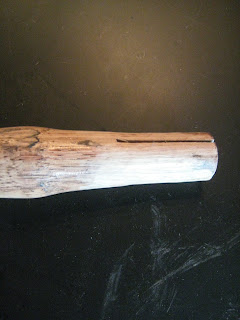I present to you my Kabuki. I pulled this bike out of a dumpster in 2002 with downtube shifters and a 5 speed freewheel. I put around 4000 miles on it in this setup. It was my transportation, recreation and I even toured a little on it. About two years ago when I was waiting for the fork on my track frame, I decided to strip down this bike and make it fixed. I took off the freewheel and threaded a track cog onto the hub secured with the old lockring from my bottom bracket and Locktite. Because of the vertical dropouts I sawed off my axle so the only thing going through the dropouts was my QR skewer and used a ½ link to achieve perfect chain tension. This clever set of hacks came to me courtesy of the late Sheldon Brown. When this setup finally failed during a skid and my cog popped off I destroyed the threading on the rear hub. Fortunately, after I changed to my winter gear ratio, my rear axle was actually centered perfectly in the rear dropout and so I was able to use the wheelset that I had been saving for my track frame. At that time I decided to strip it down and
paint it black which it still is. Once I had the fork for my track frame, I put all the parts on that and haven't built up this frame since.
I decided about a year ago that the next life of the Kabuki would be as a touring bike. I currently lack a good touring bike and this would make a very sweet one. It's got perfect geometry and the frame is pretty light. I can't think of a better frame for the job so I've started getting parts and prepping the frame.
The first step in preparing this frame to be built up is to re-space the dropouts. It was 122.5 mm and I need to get it out to 130mm to accommodate a modern 9 speed hub.
First I ran a string through the dropouts and up around the head tube to check that the frame was starting aligned symmetric.
I accomplished this alignment check by measuring the distance from the seat tube on each side out to the string. Indeed, the frame was in good shape to start out, so all I had to do was bend out each dropout the same 3.75 mm.
It looks barbaric but this delicate task is best accomplished by jamming a 2x4 under the drop out and prying up just a little. Then I re-checked the alignment to make sure that I had gotten it symmetric.
Finally I would check to see if I had gotten it out to 130 mm. I was being pretty careful not to over spread the frame, so it took 3 or 4 increments to get it there.
Although my paint job was pretty decent, I decided that I wanted to get a professional job that would last a little better and look a little nicer. The last step in prepping the frame for painting was to pop out the head cups from the headset (which desperately needs to be replaced).
And now it's ready to paint. I've already got some of the components and but I still have a bunch of parts to get together. It's going to be very pretty. You'll hear about it when it's done.











 I soak the almonds for at least 6 hours to soften up.
I soak the almonds for at least 6 hours to soften up. I usually just let them soak overnight and then I make the milk fresh in the morning for my cereal. (I took this picture of the full moon rising over the Atlantic on Jekyll Island, GA)
I usually just let them soak overnight and then I make the milk fresh in the morning for my cereal. (I took this picture of the full moon rising over the Atlantic on Jekyll Island, GA) After the almonds have soaked, I give them a quick rinse...
After the almonds have soaked, I give them a quick rinse...  ...and toss them in the blender with 3 cups of water for a total of 4 cups of stuff in the blender.
...and toss them in the blender with 3 cups of water for a total of 4 cups of stuff in the blender. Then I blend the almonds into the water on the highest setting. I've found that by leaving it blending for a full minute or longer, I get more milk out of the almonds and end up with a finer pulp.
Then I blend the almonds into the water on the highest setting. I've found that by leaving it blending for a full minute or longer, I get more milk out of the almonds and end up with a finer pulp. 





 I doubled up the foam to make a 1/4" sheet and then sewed the pad between two layers of nylon.
I doubled up the foam to make a 1/4" sheet and then sewed the pad between two layers of nylon.





























